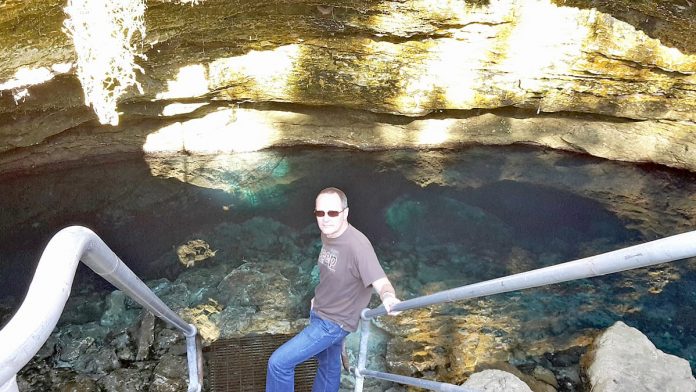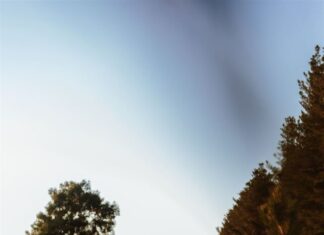

HIDDEN in a vast pine plantation on the outskirts of Mount Gambier lies one of the Lower South East’s most valued treasures – a picturesque waterfilled limestone cave system known as The Pines.
Also known as Pines Cave or simply Pines among cave divers, the cave’s limestone formations are thought to have formed perhaps half a million years ago and feature an intricate combination of underwater tunnels and chambers with names like Dark Room, Surprise Tunnel, Director’s Tomb and Air Pig Chamber.
The entrance lake of this cenote-style hole is situated only a few metres below ground level and its crystal-clear water is clearly visible from a set of steps leading to the water’s edge.
Under the water’s surface a diver first encounters a large cavern to a depth of around 25m lit by gentle daylight from above.
From there a restriction leads to an array of tunnels and chambers stretching around 200m and ending in a large chamber – the CCR Room.
An abbreviation for Crazy Czechs’ Room – the chamber was discovered in 2003 by Czech Republic cave diving couple Petra and David Funda.
The restrictive entrance to the room is at a depth of 36m, but its ceiling comes up to just 5m below the surface.
Overall The Pines reaches a maximum depth of around 43m.
Veteran cave diver and Cave Divers Association of Australia (CAA) life member Peter “Puddles” Horne said the hole has been one of the Australian cave-diving community’s most popular sites since the mid-1960s and it gained its descriptive name because of the large 1953 plantation of Californian pines (Pinus radiata) which covered this area before being felled for replanting in 2003.
“The Pines really first came to the attention of the wider cave-diving community in the late 1960s after pioneering Australian underwater adventurers and film-makers Ron and Valerie Taylor heard about the cave from local divers,” Mr Horne said.
“They recorded what was probably the first underwater footage of the cave for their film – The Cave Divers.
“The Taylors and the film’s producers demonstrated amazing foresight by including discussion about scientific aspects of both the cave and the region in their film.
“These included a fossil deposit discovery at what they thought was the bottom of a yet to be named hole in a pine forest.”
CDAA science officer and hydrogeologist Ian Lewis said The Pines is shallower than the deep sinkholes around Mount Schank because the regional limestone is thinner further inland in the Mount Gambier-Tantanoola area.
“There is a string of small caves and waterfilled cavities in this area between Burrungule, the Bluff and Tantanoola Cave.
“These occur along the large regional Tartwaup Fault Zone which stretches from the Blue Lake volcano complex through Tantanoola Cave to the Mount Burr volcanic range beyond Mount Muirhead.
“The Pines and other caves including the renowned underwater 7km long Tank Cave were formed by groundwater dissolving the limestone along fractures caused by movements and volcanic forces on the Tartwaup Fault Zone.

“As you drive along the Mount Gambier/Millicent highway, you are also driving along the Tartwaup Fault Zone and can see various springs and swamps where groundwater comes up through the limestone fractures, giving early farmers an excellent water supply.”
In term of aquatic life The Pines does not appear to contain large aquatic vertebrates such as native trout or introduced fish like red fin perch which are found in many of the region’s other sinkholes.
But, Mr Horne said it is nevertheless a very important biological site in relation to a variety of rare crustaceans and for this reason divers should take care not to unduly disturb or contaminate the water.
“The cave is one of only two sites in the world known to contain a special genus of the blind, cave-adapted amphipod (Uronyctus longicaudus) – looking something like tiny curled shrimps – the first specimens of which were collected by Dr Tom Iliffe of the Bermuda Biological Station for Research in December 1987,” Mr Horne said.
“The cave is also home to relatively rare syncarids (almost certainly Koonunga crenarum) which I discovered in nearby Fossil Cave and has a fairly healthy population of the common yabbie which are particularly abundant in the shallows at night.
“However, probably the biggest inhabitant is the Glenelg River (Ewens) Crayfish, (Euastacus bispinosuslobster) which was first reported in the main chamber in 2003.
“As these creatures are only found close to the coast and The Pines is around 20km inland, it is very likely it had been introduced to the cave.”
The Pines became Mount Gambier’s first dual-rated cave diving site giving access to both cave and advanced cave rated divers affiliated with the CDAA.
To be tackled safely, the silt-filled, more restrictive areas in the cave require a high degree of competency in the skills and knowledge related to penetration cave diving techniques and equipment.
The entrance to these areas is clearly marked and restricted to advanced cave divers only.
Until the early 1980s divers had no idea whatsoever about the overall shape of the cave or its underwater extent.
And it was only in 2003 with the Fundas’ discoveries that the cave’s full scope was realised.





